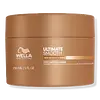What's inside
What's inside
 Key Ingredients
Key Ingredients

 Benefits
Benefits

 Concerns
Concerns

 Ingredients Side-by-side
Ingredients Side-by-side

Water
Skin ConditioningStearyl Alcohol
EmollientBehentrimonium Chloride
PreservativeCetyl Alcohol
EmollientPhenoxyethanol
PreservativeBetaine
HumectantParfum
MaskingPanthenol
Skin ConditioningIsopropyl Alcohol
SolventPropylene Glycol
HumectantQuaternium-80
Valine
MaskingGlyceryl Oleate
EmollientTocopheryl Acetate
AntioxidantOleic Acid
EmollientSqualane
EmollientMalic Acid
BufferingLimonene
PerfumingLinalool
PerfumingAminomethyl Propanol
BufferingHistidine
HumectantCitric Acid
BufferingLecithin
EmollientAscorbyl Palmitate
AntioxidantTocopherol
AntioxidantHydrogenated Palm Glycerides Citrate
EmollientWater, Stearyl Alcohol, Behentrimonium Chloride, Cetyl Alcohol, Phenoxyethanol, Betaine, Parfum, Panthenol, Isopropyl Alcohol, Propylene Glycol, Quaternium-80, Valine, Glyceryl Oleate, Tocopheryl Acetate, Oleic Acid, Squalane, Malic Acid, Limonene, Linalool, Aminomethyl Propanol, Histidine, Citric Acid, Lecithin, Ascorbyl Palmitate, Tocopherol, Hydrogenated Palm Glycerides Citrate
Water
Skin ConditioningCetearyl Alcohol
EmollientGlycerin
HumectantIsopropyl Myristate
EmollientStearamidopropyl Dimethylamine
EmulsifyingOlea Europaea Fruit Oil
MaskingMusa Paradisiaca Fruit Juice
Skin ConditioningGlycine Soja Oil
EmollientHelianthus Annuus Seed Oil
EmollientRosmarinus Officinalis Leaf Extract
AntimicrobialCocos Nucifera Oil
MaskingPersea Gratissima Oil
Skin ConditioningButyrospermum Parkii Butter
Skin ConditioningSodium Hydroxide
BufferingCoco-Caprylate/Caprate
EmollientHydroxypropyl Guar Hydroxypropyltrimonium Chloride
Caprylyl Glycol
EmollientCitric Acid
BufferingLactic Acid
BufferingTartaric Acid
BufferingCetyl Esters
EmollientTocopherol
AntioxidantPotassium Sorbate
PreservativeSodium Benzoate
MaskingSalicylic Acid
MaskingCaramel
Cosmetic ColorantLinalool
PerfumingEugenol
PerfumingCoumarin
PerfumingBenzyl Alcohol
PerfumingParfum
MaskingWater, Cetearyl Alcohol, Glycerin, Isopropyl Myristate, Stearamidopropyl Dimethylamine, Olea Europaea Fruit Oil, Musa Paradisiaca Fruit Juice, Glycine Soja Oil, Helianthus Annuus Seed Oil, Rosmarinus Officinalis Leaf Extract, Cocos Nucifera Oil, Persea Gratissima Oil, Butyrospermum Parkii Butter, Sodium Hydroxide, Coco-Caprylate/Caprate, Hydroxypropyl Guar Hydroxypropyltrimonium Chloride, Caprylyl Glycol, Citric Acid, Lactic Acid, Tartaric Acid, Cetyl Esters, Tocopherol, Potassium Sorbate, Sodium Benzoate, Salicylic Acid, Caramel, Linalool, Eugenol, Coumarin, Benzyl Alcohol, Parfum
 Reviews
Reviews

Ingredients Explained
These ingredients are found in both products.
Ingredients higher up in an ingredient list are typically present in a larger amount.
Citric Acid is an alpha hydroxy acid (AHA) naturally found in citrus fruits like oranges, lemons, and limes.
Like other AHAs, citric acid can exfoliate skin by breaking down the bonds that hold dead skin cells together. This helps reveal smoother and brighter skin underneath.
However, this exfoliating effect only happens at high concentrations (20%) which can be hard to find in cosmetic products.
Due to this, citric acid is usually included in small amounts as a pH adjuster. This helps keep products slightly more acidic and compatible with skin's natural pH.
In skincare formulas, citric acid can:
While it can provide some skin benefits, research shows lactic acid and glycolic acid are generally more effective and less irritating exfoliants.
Most citric acid used in skincare today is made by fermenting sugars (usually from molasses). This synthetic version is identical to the natural citrus form but easier to stabilize and use in formulations.
Read more about some other popular AHA's here:
Learn more about Citric AcidLinalool is a fragrance and helps add scent to products. It's derived from common plants such as cinnamon, mint, citrus, and lavender.
Like Limonene, this ingredient oxidizes when exposed to air. Oxidized linalool can cause allergies and skin sensitivity.
This ingredient has a scent that is floral, spicy tropical, and citrus-like.
Learn more about LinaloolParfum is a catch-all term for an ingredient or more that is used to give a scent to products.
Also called "fragrance", this ingredient can be a blend of hundreds of chemicals or plant oils. This means every product with "fragrance" or "parfum" in the ingredients list is a different mixture.
For instance, Habanolide is a proprietary trade name for a specific aroma chemical. When used as a fragrance ingredient in cosmetics, most aroma chemicals fall under the broad labeling category of “FRAGRANCE” or “PARFUM” according to EU and US regulations.
The term 'parfum' or 'fragrance' is not regulated in many countries. In many cases, it is up to the brand to define this term.
For instance, many brands choose to label themselves as "fragrance-free" because they are not using synthetic fragrances. However, their products may still contain ingredients such as essential oils that are considered a fragrance by INCI standards.
One example is Calendula flower extract. Calendula is an essential oil that still imparts a scent or 'fragrance'.
Depending on the blend, the ingredients in the mixture can cause allergies and sensitivities on the skin. Some ingredients that are known EU allergens include linalool and citronellol.
Parfum can also be used to mask or cover an unpleasant scent.
The bottom line is: not all fragrances/parfum/ingredients are created equally. If you are worried about fragrances, we recommend taking a closer look at an ingredient. And of course, we always recommend speaking with a professional.
Learn more about ParfumTocopherol (also known as Vitamin E) is a common antioxidant used to help protect the skin from free-radicals and strengthen the skin barrier. It's also fat soluble - this means our skin is great at absorbing it.
Vitamin E also helps keep your natural skin lipids healthy. Your lipid skin barrier naturally consists of lipids, ceramides, and fatty acids. Vitamin E offers extra protection for your skin’s lipid barrier, keeping your skin healthy and nourished.
Another benefit is a bit of UV protection. Vitamin E helps reduce the damage caused by UVB rays. (It should not replace your sunscreen). Combining it with Vitamin C can decrease sunburned cells and hyperpigmentation after UV exposure.
You might have noticed Vitamin E + C often paired together. This is because it is great at stabilizing Vitamin C. Using the two together helps increase the effectiveness of both ingredients.
There are often claims that Vitamin E can reduce/prevent scarring, but these claims haven't been confirmed by scientific research.
Learn more about TocopherolWater. It's the most common cosmetic ingredient of all. You'll usually see it at the top of ingredient lists, meaning that it makes up the largest part of the product.
So why is it so popular? Water most often acts as a solvent - this means that it helps dissolve other ingredients into the formulation.
You'll also recognize water as that liquid we all need to stay alive. If you see this, drink a glass of water. Stay hydrated!
Learn more about Water